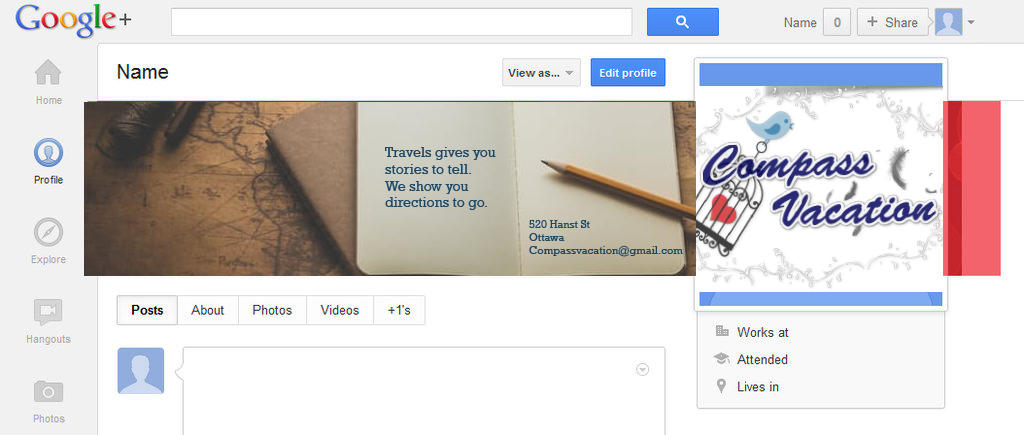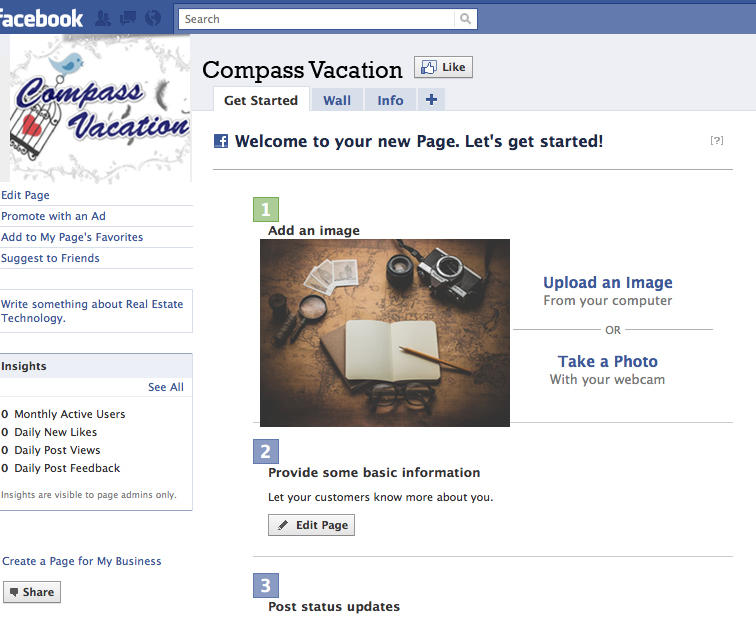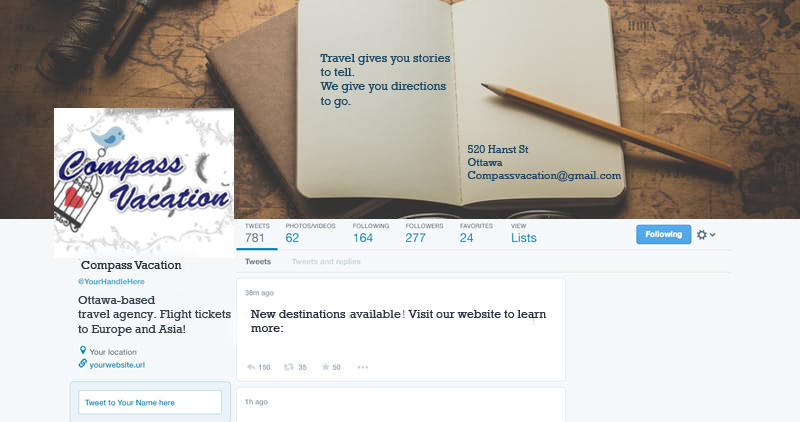In order to successfully promote the product and ensure that the connection between the brand and the customers was established, the use of social media is inevitable. If the company aims to function in social media efficiently, it has to define its SMART goals and communications mission statement.
Background and Branding
The name of the business is “Compass Vacation”; it is a travel agency that will provide tour package for its customers, as well as plane tickets for designed destinations. It is a small-sized business, and its catchment areas include several communities in Ottawa. The staff will consist of three employees: the sales manager, the social media manager, and the manager responsible for customer service via phone.
The brand’s personality will be stylish and youthful so that it could attract young adults and members of the millennial generation; however, one of the main principles that the brand will follow is being trustworthy. The customers should trust the brand and its recommendations about travel destinations, flight tickets, etc. At the same time, the brand will treat each customer friendly via the social media, answering all questions and accepting all recommendations and complaints that will be found on the social networks. The brand also needs to be “fresh” to attract customers who are tired of agencies and websites that do not address their customers in social media and only post information about sales and destinations.
The target market is foreign tourists of all ages who are interested in Asian and European cultures and attractions. The primary users of social networks are young adults and teenagers, but their interest can positively influence the engagement of older users as well (e.g. relatives, parents, teachers, acquaintances, etc.).
Competitors of Compass Vacation include such travel agencies in Ottawa as Midearth Travel, Travac Tours, and Barrhaven Travel, as they are among the most experienced travel agencies in Ottawa that focus on the same target market. The complementary businesses would be booking.com, Airbnb, TripAdvisor, agoda.com and others that can offer accommodations for our customers.
Focus and Basics
The communications mission statement is to promote the brand and raise the awareness of the brand through communication with potential customers via social channels; out mission also includes promotion of Asian and European cultures via social media.
SMART is an acronym that implies the goals are going to be specific, measurable, achievable, realistic, and time sensitive. The specific goal is to gain 1.000 followers in each of the social channels during the first two months. To measure the goal, the number of new followers will be checked every two days; the number of users who unfollowed the page will also be checked and compared to the number of the new followers. The goal is achievable and can be accomplished through promotions in other groups, use of hashtags, communication in comment sections using the profile of the brand, and likes of users’ pictures connected to travel destinations of the company. It is a realistic goal that does not demand a significant investment of money, but it is time-consuming. It seems reasonable to set a time frame of two months: if these goals are successfully accomplished, the aim for the next two months will be to gain new 1.500 followers.
The social channels chosen for the advertisement are Facebook, Twitter, and Google Plus. Facebook is one of the most popular social networks in the USA and the world; the target market is easier to access through it. Facebook also allows promotion via other groups and pages. Facebook is more popular than Twitter, but its system of short messages will allow the brand deliver only the needed information to the customers. Many travel agencies use Twitter as promotion template and raise awareness of the brand via retweets and likes. Google Plus is not a network that is used by the young generations; however, it will allow promoting the brand among professional communities and representatives of the older generations. Moreover, the business promoted through Google Plus can be found on the first page of the Google search, together with ratings and additional information about the company. Any posts that will be published on the Google Plus page have the potential to rank in the search results and attract new customers or unique visitors.



Policies and Procedures
As thousands of people visit social networks each day, certain rules need to be followed to assure that the company’s actions in social networks will bring no harm to the business and the customers.
- Employees of the company will not be allowed to post any sensitive information about it on the social media.
- Any content that is discriminative towards any social group is prohibited from posting.
- Comments containing explicit language will be deleted.
- No content that is protected by the copyright will be posted unless the company has the right to do so.
- The company is prohibited from giving out any personal information about the customers, including phone numbers, e-mail addresses, etc.
- Use of the social networks should not be abused by the employees and interfere with the working process.
Management
Daily schedule for social networking activity:
Post Examples
- Good morning! Did you know that during the Icelandic polar summer, the sun never sets? (attach a picture of the polar summer). You can experience the Icelandic summer, just book tickets on our website (include a link to the website).
- If you want to drink German beer and eat a Turkish kebab, no need to choose between the countries: hundreds of Kebab restaurants are waiting for you in Berlin! (include a link to plane tickets to Berlin).
- Wanna feel young? Visit Disneyland in Paris! (include a link to the website and a picture of the Disneyland).
Google Plus
- (include the picture of Burj Khalifa) Do you know how tall this building is? Book tickets to Abu-Dhabi and find out! (include a link to the website).
- (post a short documentary about Japan) Here is an interesting video about the Japanese culture. Experience it live and book the tickets to Tokyo tight now! (include a link to the website).
- What is the largest shopping mall in the world? Visit our website and find out! (include a link to the plane tickets to Dongguan, China).
- Over one billion speakers speak Mandarin Chinese. Learn the language and visit the country of the most widespread language in the world! (include a link to the plane tickets to China).
- This vine was filmed in Iceland during the Aurora Borealis season. It is more beautiful IRL! (include a link to the plane tickets to Reykjavik and a vine depicting Aurora Borealis).
- What is the largest archipelago in the world? (include a link to plane tickets to Indonesia).
Measuring the Success/What-If Scenarios
The metrics around retweets, likes, new followers, reposts, etc. are to show the efficiency of the campaign; it will also be possible to evaluate if the awareness of the brand has risen using the number of mentions in social networks (Hajian & White, 2012). The real-world numbers are the 1.000 followers that the company hopes to reach during the two months of the campaign. If each of the social networks will have 1.000 followers or more, the campaign will be considered successful.
If some of the countries or destinations are going viral on Twitter, it is possible to use hashtags in order to attract more customers and promote these destinations. However, such approach is unethical if the event that is going viral is connected to deaths or illnesses.
Another “real-time what-if” scenario is to engage the customers of the company share their stories on the Facebook page or allow the company to share them on Twitter and Google Plus. Authentic pictures will be more attractive to potential customers than the ones taken from the web.
The last scenario is a client’s dissatisfaction expressed via social networks and comment sections. In this case, the company needs to contact the customer and analyze the situation. Only if the customer’s complaints were not objective, it is possible to delete the comment. Nevertheless, the company needs to leave a message explaining the situation to the customers.
Reference
Hajian, B., & White, T. (2012). On measurement of influence in social networks. Proceedings of the 2012 International Conference on Advances in Social Networks Analysis and Mining, 2(2), 101-105.